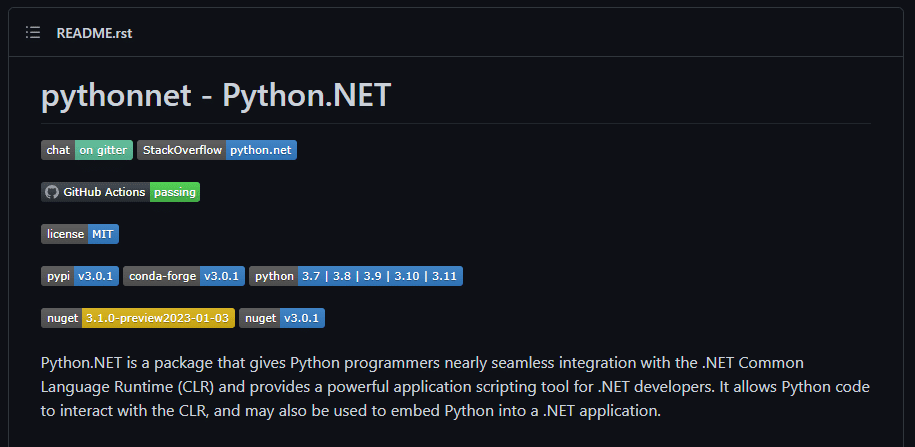Content that is all about the .NET (dotnet) ecosystem! Find examples of code often written in C# along with tutorials.
In C# 9.0 we received access to a great quality of life type called the record. You can read more about that from Microsoft here. Record types allowed us as dotnet programmers to skip a lot of boiler plate code, thereby saving us time and making code more readable. Wins all around! Before record types, we might have simple data transfer objects (called DTOs) that would look something like the following: public sealed class MyData { public MyData( string value1, int value2) { Value1 = value1; Value2 = value2; } publc string Value1 { get; } publc int Value2 { get; } } And for a simple class with two properties... I think we can all agree that the verbosity here is just over the top. With the record type that we were given access to, we can now write…
Python is a powerful and versatile programming language that has become increasingly popular. For many, it's one of the very first programming languages they pick up when getting started. Some of the highest traffic posts on my blog many years after they were written look at using C# and Python together. Today we're going to explore how you can use Python from inside a C# .NET Core application with much more modern approaches than my original articles. Enter Pythonnet! Pythonnet Package & Getting Started We're going to be looking at Python for .NET in order to accomplish this goal. This library allows you to take advantage of Python installed on the running machine from within your .NET Core applications. You must configure it to point at the corresponding Python DLL that you'd like to use, and after a couple of…
I love dependency injection frameworks ever since I started using them. Specifically, I'm obsessed with using Autofac and I have a hard time developing applications unless I can use a solid DI framework like Autofac! I've recently been working with Xamarin and found that I wanted to use dependency injection, but some of the framework doesn't support this well out of the box. I' was adamant to get something going though, so I wanted to show you my way to make this work. Disclaimer: In its current state, this is certainly a bit of a hack. I'll explain why I've taken this approach though! In your Android projects for Xamarin, any class that inherits from Activity is responsible for being created by the framework. This means where we'd usually have the luxury of passing in dependencies via a constructor and…
CircleCI is a service that I heard about from a friend that allows you to get continuous integration pipelines built up for your repositories... And it does it quick and easy. Also, free if you're someone like me and you don't have a large demand for getting builds done! I wanted to write about my experience with getting CircleCI wired up with BitBucket, which I like to use for my project hosting, and hopefully it'll help you get started. First thing, signing up is super easy if you have BitBucket because you can oauth right away with it. CircleCI will show you your projects & repositories that you have in BitBucket and you can decide which one you'd like to get started with. You can navigate to the projects in their new UI from the "Add Projects" menu. When you…
xUnit tests not running with .NET standard project settings? Here's a super quick solution to get you back up and running so you can test away!
Organizing code into Autofac modules can make maintaining code much easier and improve extensibility! It all starts with the Autofac module class. Check it out!
In Unity3D, the scripts we write and attach to GameObjects inherit from a base class called MonoBehaviour (and yes, that says Behaviour with a U in it, not the American spelling like Behavior... Just a heads up). MonoBehaviour instances can be attached to GameObjects in code by calling the AddComponent method, which takes a type parameter or type argument, and returns the new instance of the attached MonoBehaviour that it creates. This API usage means that: We cannot attach existing instances of a MonoBehaviour to a GameObject Unity3D takes care of instantiating MonoBehaviours for us (thanks Unity!) ... We can't pass parameters into the constructor of a MonoBehaviour because Unity3D only handles parameterless constructors (boo Unity!) So what's the problem with that? It kind of goes against some design patterns I'm a big fan of, where you pass your object's…
Why Consider Using Autofac With Unity3D? I think using a dependency injection framework is really valuable when you're building a complex application, and in my opinion, a game built in Unity is a great example of this. Using Autofac with Unity3D doesn't need to be a special case. I wrote a primer for using Autofac, and in it I discuss reasons why it's valuable and some of the reasons you'd consider switching to using a dependency container framework. Now it doesn't need to be Autofac, but I love the API and the usability, so that's my weapon of choice. Building a game can result in many complex systems working together. Not only that, if you intend to build many games it's a great opportunity to refactor code into different libraries for re-usability. If we're practicing writing good code using constructor…
Looking to get started using dependency injection with Autofac in your projects? Here's a quick primer on what it is and how to get going for your next project.
Unity3D Default .NET Framework I recently wrote that I wanted to start writing more Unity3D articles because I'm starting to pick up more Unity3D hobby work. It felt like a good opportunity to share some of my learnings so that anyone searching across the web might stumble upon this and get answers to the same problems I had. Unity3D as of 2018.1.1f1 (which is the version I'm currently using), still defaults to using .NET 3.5 as the framework version. Nothing wrong with that either. I'm sure there are reasons that they have for staying at that version, probably because of Mono and cross platform reasons if I were to guess, so I'm not complaining. For reference, this setting in Unity3D is referred to as "Scripting Runtime Version". So if you're googling more about this later, that's what Unity calls it.…





